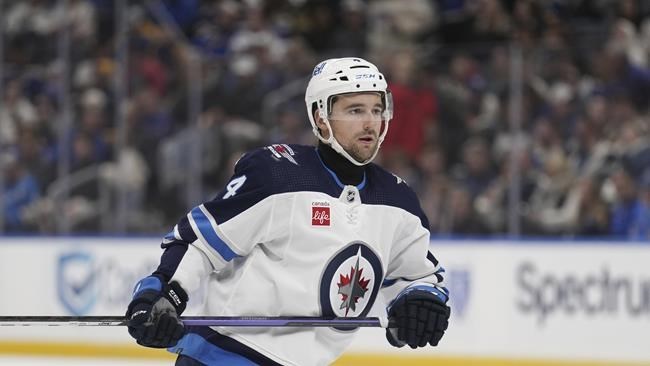TORONTO — Rod Pasma didn't see a lot of new options on the market for neck protection a month ago.
The NHL's vice-president of hockey operations now has a pile of products awaiting approval after a death from a skate cut in England.
"We're getting there," Pasma said of what is available to players in his league. "Up to eight companies on my desk waiting to be cleared.Â
"And of those eight, there's probably 12 to 14 (neck guards) to wear, should they choose."Â
Pasma gave a presentation to NHL general managers at the league's annual Toronto meeting Tuesday on cut-resistant equipment — an issue at the forefront of hockey's safety debate following the death of Adam Johnson after his neck was contacted by a skate blade during an Elite Ice Hockey League game Oct. 28.Â
"When we first started this a long time ago ... the options for the players weren't as available as they needed to be," Pasma told reporters after the session at a downtown hotel broke.Â
He said there are at least 10 options for wrist and base layer protection from cuts, and 12 more for socks.
"That element of cut protection has disappeared," Pasma said of limited alternatives. "If you think something's too hot, if you think it's too heavy, there's options."Â
The Edmonton Oilers had a scary incident last season when forward Evander Kane's arm was cut badly in a game.
"Everybody saw what happened to the player over in (England), and once it's too much," Oilers GM Ken Holland said. "More of our players now are wearing cut-resistant things on their own.
"Certainly we're encouraging all our players to wear cut-resistant material."Â
Dallas Stars GM Jim Nill said getting more technology pushed out is key.
"There's only so many companies that make this stuff," he said. "If you're a business, it's not a big market."
Any move for mandatory neck protection would have to be collectively bargained with the players — like helmets and visors in the past — but some have taken it upon themselves to wear the new equipment following Johnson's death.
"I think almost all players are thinking that way," Nill said.
NHL Players' Association executive director Marty Walsh said this week the current makeup of his membership is used to neck guards at most lower levels before entering the league.
"I don't think it's a mindset change," Walsh said Monday at a Toronto sports conference. "Players have worn it forever. When we get to that point, we want to make sure, whether it's voluntary (or not) ... that the material, the equipment that's available, actually does what it's supposed to do so players don't have a false sense of security."Â
The NHL's medical director, Dr. Willem Meeuwisse, also made a presentation to GMs about emergency standards in arenas.
"We're reviewing it constantly," he said Tuesday. "In the spring, we actually did a big education session with the doctors and trainers on major lacerations. We're always looking at what could happen.Â
"And hopefully, we don't have the bad outcome that happened a few weeks ago."Â
As for the game, GMs discussed potential tweaks to 3-on-3 overtime aimed at preventing teams from leaving the offensive zone in order to maintain possession.
"We don't want more whistles," NHL senior vice-president and director of hockey operations Colin Campbell said. "We (don't) want more faceoffs."
Some ideas on the table ahead of the next round of GM meetings in March include not allowing players to track back across the blue line or red line with the puck.
The introduction of a shot clock was also mentioned.Â
"We're constantly trying to make the game better," Campbell said. "I think we've done a pretty good job with that."
Holland said the league will provide statistics related to OT shots on goal and changes of possession when managers reconvene in four months.
"It's entertaining ... maybe not quite as entertaining," he said of the extra period. "The (faceoff) is really important — the opening draw — because the team that gets it seems to hang onto the puck for a while."Â
"Coaches (and) players are good at finding different ways to do things," Nill added. "We just want to make sure there's still excitement."Â
The NHL moved from 4-on-4 to 3-on-3 overtime in 2015-16 in hopes of reducing the number of shootouts.Â
Canucks head coach Rick Tochett said the league needs to be careful on this file.
"I watch 3-on-3 and I see (Nathan) MacKinnon, (Leon) Draisaitl and (Connor) McDavid still get their looks," he said in Vancouver. "We get our looks. I'm not sure what you can do. Maybe you regroup it twice and blow the whistle?Â
"But that's a judgment call from the refs."
Campbell said the league is looking for teams to collect and share information and opinions.
"We told (GMs) to take it back to their coaches," Campbell said of the OT ideas debated Tuesday. "Unintended circumstances are always considered with these things."
-With files from Nick Wells in Vancouver.
This report by The Canadian Press was first published Nov. 14, 2023.Â
___
Follow @JClipperton_CP on X.
Joshua Clipperton, The Canadian Press




